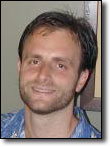
2005 IEEE International Conference on Acoustics, Speech, and Signal Processing
March 18-23, 2005 • Pennsylvania Convention Center/Marriott Hotel • Philadelphia, PA, USA
ICASSP
30th Anniversary
Tutorial TUT-5: Music Information Retrieval
Instructors
G. Tzanetakis; University of Victoria
Time & Location
Saturday, March 19, 09:00 - 12:00, Location: CC: Room 109
Abstract
Music has always been profoundly transformed by advances in technology. Examples of such transformations include the use of music notation, the invention of recording and more recently digital music storage and distribution. Portable music players such as Apple's iPods can today store thousands of songs and online music sales have been steadily increasing. It is likely that in the near future anyone will be able to access digitally all of recorded music in human history.
In order to efficiently interact with these large collections of music it is necessary to develop tools that have some understanding of the actual musical content. Music Information Retrieval (MIR) is an emerging research discipline that deals with all aspects of organizing and extracting information from music. Interest in MIR has been steadily increasing as can be evidenced by the numbers of MIR-related papers in ICASSP and other conferences as well as the fifth year existence of ISMIR which is a conference solely focused on MIR.
In this tutorial, an overview of the current state of the art in MIR with special emphasis on the use of machine learning and signal processing techniques for content-based analysis of audio signals will be provided. Many of the techniques used in MIR have their roots in more traditional areas such as Speech Recognition, Psycoacoustics and Audio Compression. However music has several unique characteristics which has led researchers to develop music-specific signal processing methods.
Outline: The tutorial will be roughly divided between the following topics:
- History and Overview of Music, Information Retrieval and Music Information Retrieval (MIR)
- Audio Feature Extraction
- Content-based Similarity Retrieval, Segmentation and Classification
- Music-specific Processing
- Query-by-humming
- Fingerprinting and Watermarking for musical signals
- Content-Aware User Interfaces
- Challenges and connections to other research areas
Participants will be provided with handouts of the tutorial materials, pointers to online resources, an annotated bibliography of approximately 200 papers in this area as well as software implementing many of the described algorithms.
Prerequisites / Target Audience: Familiarity with basic signal processing and machine learning at the first year graduate level is expected. Some familiarity with musical concepts such as pitch, scale, and chords would help but is not a prerequisite. The main target audience is graduate students, but also researchers interested in learning about how signal processing techniques can be applied to the processing of music signals.
Presenter Information

George Tzanetakis (S'97, M' 02) is an assistant Professor of Computer Science at the University of Victoria, Canada. He received his PhD degree in Computer Science from Princeton University under the supervision of Prof. Perry Cook in May 2002 and was a PostDoctoral Fellow at Carnegie Mellon University working on query-by-humming systems with Prof. Dannenberg and on video and audio retrieval with the Informedia group. In addition he was chief designer of the audio fingerprinting technology of Moodlogic Inc. and developed a real-time music speech classification system for All Music Publishing, The Netherlands.
His research deals with all stages of audio content analysis such as feature extraction, segmentation, classification with specific focus on Music Information Retrieval (MIR). His work on musical genre classification is frequently cited and he has presented tutorials on MIR and audio feature extraction at several international conferences. He is assistant editor of Computer Music Journal and was Publications Chair for the International Computer Music Conference in 2004. He is also an active musician and has studied saxophone performance, music theory and composition. More information can be found at: http://www.cs.uvic.ca/~gtzan.